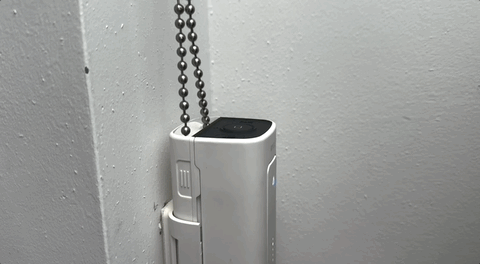I recently moved into a new apartment, and considering that I try to live within three smart home ecosystems at once – Apple Home, Google, and Amazon Alexa – it was a chance to have a bit of a reset with my smart home, weed some things out and also add in some new smart gadgets.
My new spot has a bevy of windows, which is a major win for natural sunlight, but also a ton of classic shades that use a metal-beaded design for raising and lowering. That’s when I realized: wouldn’t it be cool to open or close them with the tap of an app or to ask via a smart assistant?
That led me to discover Ryse, the SmartShade controller maker that brings plastic or metal beaded chains into the 21st century. Yes, it’s not necessarily a needed purchase, but while pricey, it does make for compelling home automation… and, yes, a cool party trick.
Wired or battery
I’ve been testing two SmartShades with Battery Packs, essentially the self-powered version of the controllers that will eventually need a recharge. I think they’re likely the better option for renters as you don’t need to hunt around for an outlet to always provide power to the controller.
Ryse makes both options, though – priced at $149.99 for wired or $199.99 for battery. The SmartBridge, which enables out-of-home control and lets them integrate with Alexa, Google Home, or Apple Home, is $80. So, it’s not the world’s cheapest upgrade, but it does set out to do what it means to do.
A simple setup, but you’ll want it to be secure
The price isn’t cheap, but the SmartShade Controller is a pretty well-built albeit hefty piece of kit. It’s a rectangle with a pairing and power button on the top, an up arrow and down arrow on the front for raising or lowering the window shade, and a spot to configure the plastic or metal beaded chain into the rear.
Folks with these types of shades likely know they can be finicky, so make sure you install it right. Luckily, the Ryse app for iOS and Android mostly walks you through this well, and the included paper instructions fill in the missing gap.
The onboarding is easy, though – create an account, connect to the SmartShade, and set your open and closed positions. That pair is manual, but once set, the Ryse system is smart enough to know the various stages in between, so you can easily set it to be open 50%, 75%, or even 18%.
In my experience, setting up the SmartShade takes about 5 to 10 minutes, so it takes about 20 minutes for the pair. They then take to the SmartBridge pretty quickly, enabling more advanced control options, and setting it up with Apple Home, Amazon Alexa, or Google Home. That’s where the real magic kicks in, as Ryse offers some light automation, but integrating with your preferred system is a bit easier.
Whether using the Ryse app or integrating with a smart home ecosystem, the shades were quick to respond to commands – be it raising or lowering completely – and even stopping at a more custom spot. It also doesn’t make much noise, thanks to the motor inside being under a few decibels; I mostly had the light chime of the metal chain moving.
I only encountered one major issue – my left top shade chain actually broke while the Ryse was moving it up and down, and it speaks to needing to secure the units pretty well. The SmartShade box includes a mounting bracket with screws; you’ll want to make sure you do use it, as the controller can’t be rocking around or free-standing while pulling on the chain. It will also add weight to it and add extra stress.
If you prefer not to drill, renters can use some heavy-duty command strips or a similar adhesive, but make sure it’s on tight. In the end, I was able to easily fix the metal chain, but still, it’s not a fun experience. Luckily, it hasn’t happened since with that fixed unit or my top-right shade.
So yes, the Ryse SmartShade is an expensive but genuinely handy smart home gadget. It’s a bit of a niche market to want to add smart controls to chain shades, but it’s likely cheaper than going out and upgrading an entire shade or blind system. I will also say being able to pop into Apple Home or Google Home and quickly adjust the shades, close them while in bed, or even set the scene for a movie night is really handy. Equally, it’s cool to ask Siri to do the same.
If you’re looking for one and can stomach the cost, the Ryse controller and the bridge are excellent together. I just wish there were some onboarded smarts native to the SmartShade, but that’s more par for the course with smart home gadgets.

